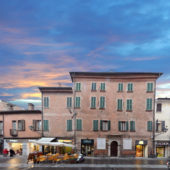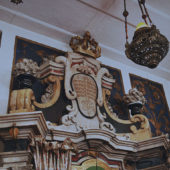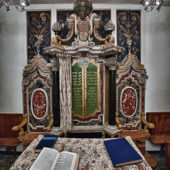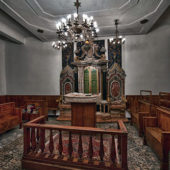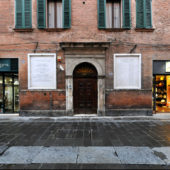The most intimate of the 3 synagogues housed in a single building.
Most unusually, to enter this synagogue, one enters through a door from the 1800s that is mounted upside down. Text on the door is inscribed in Hebrew, “May they just come to me.” This was intended to greet the worshippers as they entered the room, not as they left! Inside, the rectangular stucco-decorated walled prayer room proudly displays an elegant polychrome marble Aron Kodesh from Cento, dating back to the 1700s. It was restored to its original condition after the damage done it during WWII. The torah doors are flanked by marble columns and by two seats with multi-colored marble inlay. Twin tablets displaying ‘The Ten Commandments’ inscribed in Hebrew sit at the top of the Aron Kodesh, amongst elegant spirals and floral decorations. The torah scrolls inside the Aron Kodesh are from a synagogue in Lugo. The tivah (reader’s desk), also from Cento, is situated in the center of the room, surrounded by benches.
Continuing on from the foyer on the ground floor, one arrives in a small, rectangular courtyard. On the right are two antique white marble columns (newly installed), which support the traditional huts built each year by the community when celebrating Succoth. On the left wall are several ancient collection boxes. The first is dated 1672 and the second, 1656, with the word zedakà (“justice”) above its door. This was a term used to describe an act of charity. A third collection box, also dated 1656, was used for offerings for oil to illuminate the temple. A further two collection boxes, dated 1652, for the school, and 1742, for a variety of offerings, are dilapidated. These two are located past the arch where the staircase is located, that leads to the prayer areas and the museum. The courtyard also incorporates a red marble fountain on one of its walls (dated 1593), for ritual hand-washing prior to entering the synagogue. There are commemoration tablets on the walls, honoring those who have made substantial contributions to the community. One of the tablets is in memorial of the Norsa family who purchased this building and donated it to the Jewish community, to be utilized as a center of prayer and study. Up a flight of stair is the entrance to the Scola Tedesca synagogue.
Ferrara is the only city in the Emilia-Romagna region of Italy to boast an uninterrupted Jewish presence from the middle ages to the present. The first definitive record of Jews in the city is a notarized document referencing Sabatinus Judeus, together with several other documents, all of which date back to 1227. According to other archives found, seventeen Jewish families lived in the Via Boccacanale area of Ferrara in 1310. Further documents reveal a continued Jewish presence in the city since that time. After 1400, there is evidence that Jews in Ferrara began to live in an area later selected for the ghetto. However, prior to that time, the Jewish community flourished under the government of the Este family. They were allowed to practice a variety of commercial and professional occupations – not just money lending, as was common in many parts of Italy.
At the end of the 15th century and the first half of the 16th century, Ferrara welcomed Sephardic Jews (who were expelled from Spain and Portugal in 1492), and in approximately 1532, groups of Ashkenazi Jews (of German origin) were also accepted into the city. As a result, the Jewish community increased significantly. Out of a population of 30,000 people, 2,000 of them were Jews. Ferrara became a melting pot for different Jewish cultures. There were many cultured and important Jewish figures making their home in Ferrara. When Duke Alfonso d’Este died in 1597, without having produced any male heirs, conditions took a turn for a worse for the Jewish community. Ferrara was annexed by the Papacy and Duke Cesare d’Este transferred his court to Modena. Therefore, many Jews left Ferrara. Those who stayed saw their freedoms and rights diminished or denied.
In 1627 a ghetto was forced upon the Jewish community, followed by a period of persecution and humiliation. The community found solace in studying their sacred texts. During their time in the ghetto, many rabbis became leading experts in their fields of study. The Jews were released from the ghetto in 1859, due to the annexation of Ferrara to the Kingdom of Italy. After the destruction of the ghetto barriers, the following decades saw the Jews of Ferrara experimenting with complete integration into the social fabric of the city. In 1938 racial laws were instituted. This was followed by Nazi and Fascist deportations, which devastated the city. 96 Jews were deported to concentration camps and not one returned. Today, there are approximately 80 members of Ferrara’s Jewish community.
Ferrara boasts three synagogues, which are actually in the same building in which they were originally housed in, since 1485. Two of these synagogues continue to be in use today. There are different synagogues to provide worship according to the different rites. The façade of the building is identical to the surrounding buildings, which was common in order to escape persecution. Post WWII, memorial tablets were put up, flanking the front door, listing the names of the Jews from Ferrara who were deported to concentration camps between 1943 and 1945. Inside, the structure is rather like a labyrinth, which although recently renovated, reveals the combination of different architectural styles added over the years, creating an intriguing, eclectic atmosphere. In the foyer, a sweeping staircase leads to an imposing safe in wood, decorated with black studs. This most likely dates back to the 17th century. Offices and the rabbi’s home also inhabit the first floor, together with the Fanese-rite (Scola Fanese) synagogue.

